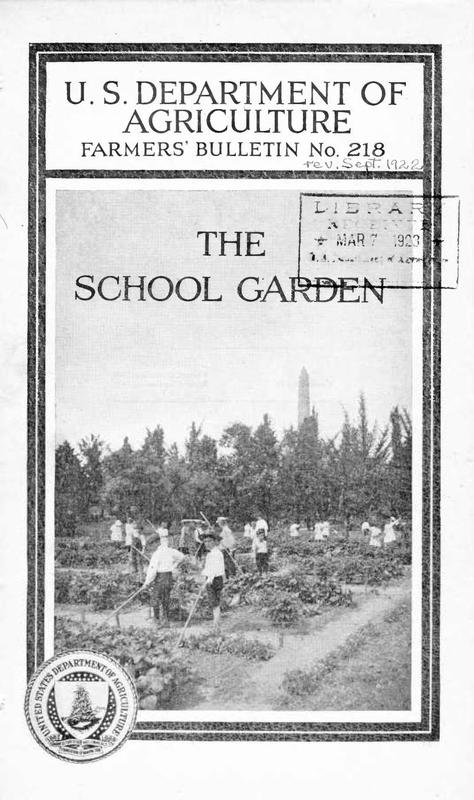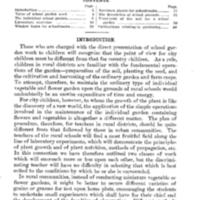The School Garden
Creator
Date
1922
Relation
Excerpt
Those who are charged with the direct presentation of school garden work to children will recognize that the point of view for city children must be different from that for country children. As a rule, children in rural districts are familiar with the fundamental operations of the garden — preparation of the soil, planting the seed, and the cultivation and harvesting of the ordinary garden and farm crops. To attempt, therefore, to maintain the ordinary type of individual vegetable and flower garden upon the grounds of rural schools would undoubtedly be an unwise expenditure of time and energy.
For city children, however, to whom the growth of the plant is like the discovery of a new world, the application of the simple operations involved in the maintenance of the individual garden containing flowers and vegetables is altogether a different matter. The plan of procedure, therefore, for teachers in rural districts, should be quite different from that followed by those in urban communities. The teachers of the rural schools will find a most fruitful field along the line of laboratory experiments, which will demonstrate the principles of plant growth and of plant nutrition, methods of propagation, etc. In this connection we have therefore outlined two classes of work which will encroach more or less upon each other, but the discriminating teacher will have no difficulty in selecting that which is best suited to the conditions by which he or she is surrounded.
In rural communities, instead of conducting miniature vegetable or flower gardens, it might be better to secure different varieties of grains or grasses for test upon home plats, encouraging the students to undertake small experiments which shall have for their chief end the development of the faculties of observation. Different methods of tillage and fundamental principles of this character will be involved in these experimental or demonstration areas, the results of which will emphasize the importance of certain lines of work.
In some localities it will be possible to bring together upon the school grounds groups of shrubs and trees arranged in an artistic manner, so that the finished work will present an attractive picture and will furnish material of great value for purposes of instruction. The habits and uses of various plants can be brought out and the child led to appreciate the value of such decorative plantings in connection with the home. Such work, however, will not involve any very considerable expenditure of time or energy, neither will it require systematic attention to garden work on the part of the child. It will, however, have a broader and less exacting influence, and will, perhaps, be of greater importance in rural communities than would close attention to the maintenance of the individual garden.
For city children, however, to whom the growth of the plant is like the discovery of a new world, the application of the simple operations involved in the maintenance of the individual garden containing flowers and vegetables is altogether a different matter. The plan of procedure, therefore, for teachers in rural districts, should be quite different from that followed by those in urban communities. The teachers of the rural schools will find a most fruitful field along the line of laboratory experiments, which will demonstrate the principles of plant growth and of plant nutrition, methods of propagation, etc. In this connection we have therefore outlined two classes of work which will encroach more or less upon each other, but the discriminating teacher will have no difficulty in selecting that which is best suited to the conditions by which he or she is surrounded.
In rural communities, instead of conducting miniature vegetable or flower gardens, it might be better to secure different varieties of grains or grasses for test upon home plats, encouraging the students to undertake small experiments which shall have for their chief end the development of the faculties of observation. Different methods of tillage and fundamental principles of this character will be involved in these experimental or demonstration areas, the results of which will emphasize the importance of certain lines of work.
In some localities it will be possible to bring together upon the school grounds groups of shrubs and trees arranged in an artistic manner, so that the finished work will present an attractive picture and will furnish material of great value for purposes of instruction. The habits and uses of various plants can be brought out and the child led to appreciate the value of such decorative plantings in connection with the home. Such work, however, will not involve any very considerable expenditure of time or energy, neither will it require systematic attention to garden work on the part of the child. It will, however, have a broader and less exacting influence, and will, perhaps, be of greater importance in rural communities than would close attention to the maintenance of the individual garden.
Title
The School Garden
File(s)
The School Garden Cover.jpg
(image/jpeg)
The School Garden TOC.jpg
(image/jpeg)
 An official website of the United States government.
An official website of the United States government.



